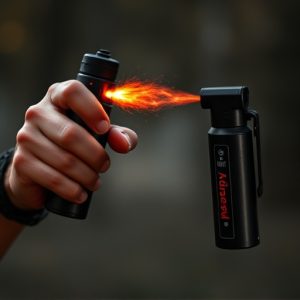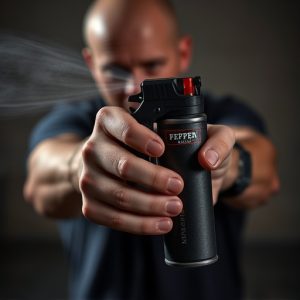Safe Pepper Spray Use: Legal, Equipment, and Handling Insights
"Law enforcement uses pepper spray as a less-lethal option for crowd control and immediate thre…….
"Law enforcement uses pepper spray as a less-lethal option for crowd control and immediate threats, guided by legal frameworks. Its safe deployment requires comprehensive training, well-maintained equipment, and strict adherence to protocols. Pepper spray temporarily neutralizes targets, allowing de-escalation. Effective use demands proper training in application techniques, high-quality equipment, regular maintenance, and tactical decision-making, prioritizing community safety and minimizing risks."
“In today’s dynamic law enforcement landscape, understanding and implementing pepper spray equipment is crucial for maintaining public safety. This comprehensive guide explores ‘when to use pepper spray safely’ from a legal perspective, delving into deployment scenarios, clear guidelines, and the latest equipment considerations. From recognizing unclear situations to ensuring proper training, we navigate the intricate balance between de-escalation techniques and effective crowd control. Discover best practices for responsible pepper spray use.”
- Understanding Pepper Spray: A Legal Perspective
- When is Pepper Spray Deployed? Unclear Situations and Escalation
- Safe Handling and Training: Ensuring Officer and Public Safety
- Equipment Considerations for Effective and Responsible Pepper Spray Use
Understanding Pepper Spray: A Legal Perspective
Pepper spray, officially known as oleoresin capsicum (OC) spray, is a powerful tool used by law enforcement and security personnel for crowd control and to subdue individuals during various situations. Its primary active ingredient, capsaicin, triggers a burning sensation in the eyes, nose, and throat when sprayed, temporarily impairing an individual’s vision and ability to breathe, thereby enabling officers to gain control or arrest them safely.
The legal perspective on pepper spray is nuanced; its use must adhere to specific guidelines that vary by jurisdiction. Generally, law enforcement agencies authorize the use of OC spray as a less-lethal option when other force isn’t immediately viable. The “when to use” considerations include situations like active assaults, armed individuals, or crowd disturbances where de-escalation strategies have failed. Ensuring safe and responsible use involves proper training, equipment maintenance, and adherence to protocols designed to minimize risk to both officers and civilians.
When is Pepper Spray Deployed? Unclear Situations and Escalation
Pepper spray is a widely used tool by law enforcement agencies for crowd control and managing unruly situations. It’s deployed when other de-escalation tactics fail or in cases where an individual poses an immediate threat to officers or others. The decision to use pepper spray should be made with caution, considering the specific circumstances of each incident.
Unclear or escalating situations often prompt its use. For instance, during demonstrations or protests that turn violent, pepper spray can help disperse a crowd and protect both civilians and law enforcement. Similarly, if an individual becomes aggressive, resistive, or poses a danger to themselves or others, officers may employ pepper spray as a means of control. When used safely and appropriately, pepper spray temporarily incapacitates the target, providing time for the situation to de-escalate or for backup to arrive.
Safe Handling and Training: Ensuring Officer and Public Safety
Law enforcement pepper spray equipment is a powerful tool, but its safe handling and proper training are paramount to ensuring both officer and public safety. Agencies must provide comprehensive training programs that cover not just the technical aspects of deploying pepper spray, but also the tactical decision-making required in various scenarios. This includes teaching officers when to use pepper spray safely, emphasizing de-escalation techniques first, and understanding the limitations and potential risks associated with its use.
Regular simulations and practical exercises allow officers to gain hands-on experience while minimizing actual risk. Additionally, continuous training updates are crucial to keeping up with evolving best practices and ensuring officers remain proficient in their use of force options. Prioritizing safe handling and thorough training not only protects individuals within the community but also safeguards law enforcement personnel from potential harm.
Equipment Considerations for Effective and Responsible Pepper Spray Use
When law enforcement officers need to control a situation or subdue an individual, pepper spray is often a crucial tool in their arsenal. However, its effective and responsible use hinges on proper equipment considerations. To start, officers should be trained in the correct application techniques, ensuring they can deploy the spray accurately while minimizing risks to themselves and bystanders. The right equipment includes high-quality, durable spray canisters designed for tactical use, with a range of options based on specific needs—like different concentrations or specialized nozzles.
Additionally, officers must have reliable holsters or pockets to store the canisters, easy access during emergency situations being paramount. Weather conditions and environments also play a role; waterproof casings protect the spray from rain or sweat, while temperature-resistant designs ensure the canister remains functional in extreme heat or cold. Regular maintenance of equipment is essential to guarantee its longevity and reliability, directly impacting the safety and effectiveness of pepper spray use.
Pepper spray, while a valuable tool in law enforcement, should be used responsibly and only when necessary. By understanding the legal framework, recognizing unclear or escalating situations, ensuring proper training and handling, and considering suitable equipment, officers can deploy pepper spray safely and effectively, balancing public safety with the need for force minimization.


